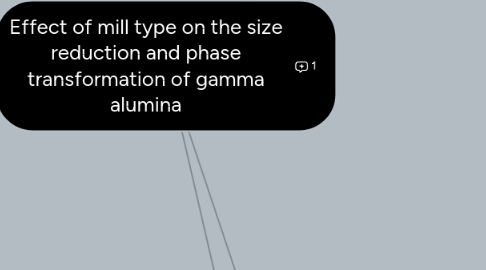
1. Initiation
1.1. Abstract
1.1.1. The influence of stress modes and comminution conditions on the effectiveness of particle size reduction of a common catalyst support; γ-Alumina is examined through a comparative assessment of three different mill types. Air jet milling is found to be the most effective in reducing particle size from a d90 of 37 µm to 2.9 µm compared to planetary ball milling (30.2 µm) and single ball milling (10.5 µm). XRD and TEM studies confirm that the planetary ball mill causes phase transformation to the less desired α-Alumina resulting in a notable decrease in surface area from 136.6 m2/g to 82.5 m2/g as measured by the BET method.
1.2. Introduction
1.2.1. Milling is a widely used industrial operation common for cases where size reduction of particles is required. It can also be known as grinding and involves the size reduction of particles smaller than 10 mm. There is a vast range of mill types available commercially and the choice of mill is based on a variety of factors, such as properties of the material to be milled, e.g. failure mode, and the required product particle size.
1.3. Materials and methods
1.3.1. The sample used for experiments is a commercially available γ-Al2O3 powder: a 99.99% pure γ-Al2O3 derived from synthetic boehmite. Single ball milling (SBM) was carried out using a Retsch MM200 vibratory single ball mill. An 11 ml stainless steel milling jar with a 12 mm diameter spherical stainless steel ball is used for single ball milling for durations of up to 1200 min at a milling frequency of 30 Hz. In single ball milling, short duration collisions dominate and the energy generated by the mill is determined by the chosen milling frequency. This can be shown by the contact force distribution reported by Kwan et al. (2005) where the impact forces are the most dominant. Size reduction is mainly by impact in the SBM although shear and attrition is also present during milling.
2. Results
2.1. 3.1. Particle size analysis using laser diffraction
2.1.1. 3.1.1. γ-Al2O3 particles before and after dry milling in the JM
2.1.2. 3.1.2. γ-Al2O3 particles before and after dry milling in the SBM
2.1.3. 3.1.3. γ-Al2O3 particles before and after dry milling in the PBM}
2.1.4. 3.1.4. Comparison of dry milling using different mills
2.2. 3.2. Characterisation of particle morphology using SEM analysis
2.3. 3.3. Characterisation of surface area using BET
2.3.1. Schedule Quality Review Meeting
2.3.2. Prepare for Quality Review Meeting
2.3.3. Conduct Quality Review Meeting
2.3.4. Follow-up Quality Review Meeting
2.4. 3.4. Characterisation of particle morphology by XRD analysis
2.4.1. Update Project Schedule
2.4.2. Update Budget / Costs
2.4.3. Conduct Team Status Review
2.4.4. Create Status Report
2.5. 3.5. Characterisation of particle morphology by TEM analysis
2.5.1. Request Changes
2.5.2. Identify Alternative Solutions
2.5.3. Conduct Steering Committee Meeting
2.5.4. Document Change Responses
2.5.5. Implement Change(s)
3. Discussion and Conclusions
3.1. Discussion of particle size and particle morphology results
3.1.1. In general, for all samples there is reasonable agreement, qualitatively, between the sizes derived using the 3 techniques as the principles of measurement of the methods are different. The primary particles are single crystal in nature, as suggested in TEM bright field images. It is important to note that the γ-Al2O3 crystallite sizes (Table 10) estimated from XRD using the Scherrer׳s equation are smaller than those observed by TEM owing to presence of a core–shell structure within γ-Al2O3 primary particles with a surface disordered shell surrounding a more ordered crystalline core as observed by Rozita et al. (2013). Crystallite sizes for the JM samples were marginally smaller than the A-R sample suggesting grain size refinement. From XRD and TEM crystallite size averages, SBM samples showed larger crystallites.
3.2. Conclusions
3.2.1. Jet milling is a more suitable size reduction method for dry milling of γ-Al2O3 powders when compared with planetary ball milling and single ball milling, as it effectively reduces size with minimal effect on the morphology of the material. Dry planetary ball milling results in a phase change from γ to α-Al2O3 as observed by XRD patterns and octahedral crystal shapes in TEM. A significant loss of surface area from 136.6 m2/g to 82.6 m2/g is evident in the planetary ball mill samples, rendering the planetary ball mill as less suitable for size reduction of catalyst supports. The observation of transformation in planetary ball milled samples can be attributed to high shear stresses in the mill that result in shear nucleation and formation of α-Al2O3. Contamination of samples with ZrO2 also occurs during planetary ball milling and is observed to increase with time. The results favour a shear nucleation mechanism of phase transformation where the formation of α-Al2O3 occurs by slip on close packed oxygen planes and results in a change from the cubic close packed to hexagonally close packed structure.
